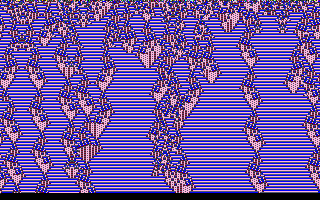| This is the (one dimensional) Life! | ||||||||
|---|---|---|---|---|---|---|---|---|

|
|
|||||||
|
popularity : 53% |
|||||||
alltime top: #59130 |
|
|||||||
|
||||||||
| added on the 2025-05-07 00:27:59 by orac81 |
||||||||
popularity helper
comments
You called it and here it is ;)
Rudi did something in 128 then in 64 bytes, then i optimized it to 55 bytes and created something similar in 24 bytes
Totalistic & Edits
Tough to compare all those 1D automatons, but yes, 32 bytes for a decent one should be enough ;)
Rudi did something in 128 then in 64 bytes, then i optimized it to 55 bytes and created something similar in 24 bytes
Totalistic & Edits
Tough to compare all those 1D automatons, but yes, 32 bytes for a decent one should be enough ;)
submit changes
if this prod is a fake, some info is false or the download link is broken,
do not post about it in the comments, it will get lost.
instead, click here !


This is an old-school (and well known) effect, but it uses a different approach to most other programs I have seen, in particular I think using MOD 5 generates interesting graphics.
When running, hit SPACE for next pattern, ESC to quit. (CLR or MODE 80 after)
See file "life1d.txt" for more details.
There is an SDL2/linux version in the zip file too. See "sdl_life" folder and "sdl_life1d.txt" for details.
There is a Turbo-C "TINYTC" version of the code (180 bytes) in the TC folder, and my original 1992 shareware version, which actually has a CGA option.
Also a load of pix in the "screenshot" folder.
I expect someone here will tell me it can be done in 32 bytes!